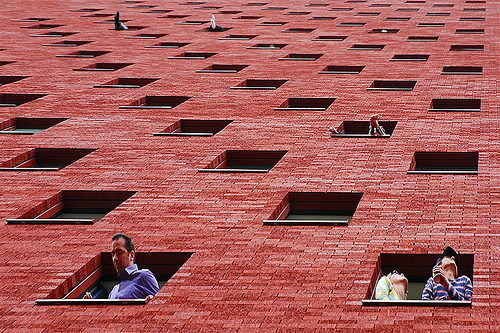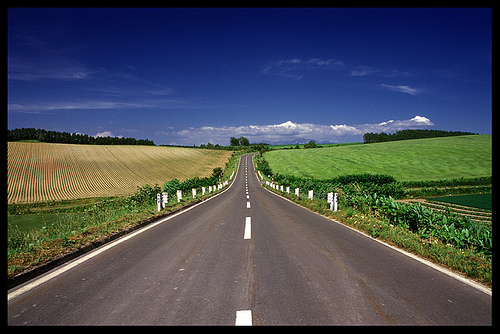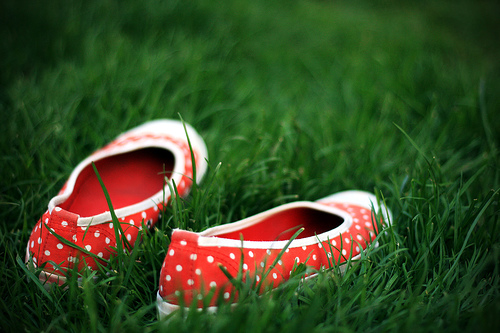- contact sheet
- best print
- that print re-printed using a filter (please label which filter used on the back of the print)
Wednesday, October 27, 2010
Landscapes Due TODAY
Monday, October 25, 2010
back to basics...
- Angles -- finding unique angles to shoot from. examples
- Filling the frame -- fill your shot with interesting stuff, examples
- Framing -- create a frame withing a frame (use objects to frame in your subject). examples
- Lines -- use lines to lead your viewer deeper into your image. examples
Friday, October 22, 2010
SUPPLIES ARE DUE MONDAY
FILM:
You will have to buy this at a camera shop, most drug stores do not sell true black and white film.
You will need 4 to 6 rolls of ASA/ISO 400 speed black and white film for this class. 24 exposures will be fine. I suggest:
- Illford HP5 400
- Kodak tri-x 400
- Kodak t-max 400
- Other 400 speed black and white films will be fine, we will just need to look up developing times for them
- NO C-41 FILM!!! THIS IS B&W FILM FOR COLOR PROCESSING, WE CAN NOT DEVELOP IT HERE.
PAPER:
8x10 paper has been provided for making contact sheets. You will need RC (Resin coated) photographic paper for this class (not fiber paper) to print your images. This again will need to come from a camera store, it needs to be paper for black and white darkroom use, not inkjet printers etc. Office supply stores and drug stores will not sell this. I suggest:
- Illford MGV Multicontrast RC paper
- Kodak Polycontrast RC Paper
- Others brands (arista, EFKE, Forte, etc. will work fine, we will just need to look up developing times for them
- 25+ sheets of 5x7 paper
WAYS TO SAVE:
If you buy in mass quantity you can save big! Share a larger quantity of paper with classmates to save. Also, if you order quick there are good deals to be had online and in catalogs!
WHERE TO BUY:
| GLAZERS 430 8th AVE N Seattle WA 206-624-1100 | KENMORE CAMERA 18031 67th AVE NE Kenmore 425-485-7447 |
| FREESTYLE PHOTO www.freestylephoto.biz | B&H PHOTO www.bhphotovideo.com |
| JIM’S CAMERA (used cameras) 1313 NE 43rd St. Seattle 206-547-1440 | CAMERA TECHS (repair & film) 2034 NW Market St Seattle 206-782-2433 |
| CAMERA CLINIC (cheap used cameras and repaird) 518 NE 165th St Shoreline 206-367-2440 |
|
a little research
Please choose a photographer from the list below (or elsewhere), find one you like, that interests you, and you would have fun researching and later emulating. Each student will be choosing a different photographer.
You will be writing a 1 pg paper about your chosen photog. In no LESS than one page (double spaces 12pt font) please explain:
• Who you selected and who they are (i.e. when, where, what etc)
• Describe their photography (what is unique about her/his style and technique), what do the photograph, how, why?
• Explain how he/she (or something they did, used, invented or created) has impacted or changed the world of photography.
• Why did you choose this photographer? What do you like about their work/style?
• Abbott, Berenice
• Adams, Ansel
• Adams, Robert
• Alvarez Bravo
• Arbus, Diane
• Atget, Eugene
• Bellocq, E.J.
• Blossfeldt, Karl
• Brandt, Bill
• Brassai
• Callahan, Harry
• Cameron, Julia M.
• Coburn, Alvin L.
• Cunningham,Imogen
• DeCarava, Roy
• Doisneau, Robert
• Eggleston, William
• Evans, Walker
• Friedlander, Lee
• Gutmann, John
• Hine, Lewis
• Kertesz, Andre
• Klein, William
• Koudelka, Josef
• Lange, Dorothea
• Lartigue,Jacques H.
• Laughlin,Clarence J.
• Levitt, Helen
• Mapplethorpe,Robert
• Modotti, Tina
• Muybridge,Eadweard
• Nadar, Felix
• O'Sullivan, Timothy
• Outerbridge, Paul
• Porter,Eliot
• Riis, Jacob
• Rodchenko,Alexander
• Salgado,Sebastio
• Sherman, Cindy
• Smith, W. Eugene
• Sommer, Frederick
• Steichen, Edward
• Stieglitz, Alfred
• Strand, Paul
• Talbot,William H. Fox
• Uelsmann, Jerry
• Weegeehttp://www.blogger.com/img/gl.link.gif
• Weston, Edward
• White, Minor
• Winogrand, Garry
Guy Bourdin
Cartier Bresson
Andreas Gursky
Annie Leibowitz
Monday, October 18, 2010
going digital:
To adjust the shutter speed you will be using the thumb click wheel:
To adjust the aperture you will need to hold down the "AV" button while using the same click wheel:

Tips: try and repeat the same action (speed, focus etc).
You will be finding a different scene/object/subject. You will photograph this 3 times using a different combination of aperture and shutter settings.
example:
photograph a flower at f8 & 1/60, f11 & 1/25, and f5.6 and 1/125. All should have the same end result in exposure but will have differing depths of field and or motion/blur.
You will need to WRITE DOWN THE CAMERA SETTINGS YOU USE FOR EACH SHOT!!!! lastly make a document in NeoOffice with your 3 images and exposure values.
Friday, October 15, 2010
Roll #3
This is the only rule for this roll of film, the rest is up to you. Though, I encourage you to consider your composition of each image:
Good Composition is a key element of good photographs yet is something that is hard to define.
Instead of looking at composition as a set of ‘rules’ to follow – I view it as a set of ingredients that can be taken out of the pantry at any point and used to make a great ‘meal’ (photograph). Alternatively I’ve often described it as a set of ‘tools’ that can be taken out of one’s compositional tool belt at any given time in the construction of a great image.
The key is to remember that in the same way as a chef rarely uses all the ingredients at their disposal in any dish – that a photographer rarely uses all of the ingredients of composition in the making of an image.
Today I’d like to look at five of the ingredients (or tools, or elements) of composition that I draw on in my photography. They’re not ‘rules’ – just things that I consider when setting up a shot.
Pattern
There are patterns all around us if we only learn to see them. Emphasizing and highlighting these patterns can lead to striking shots – as can high lighting when patterns are broken.
Read more on using repetition and patterns in photography.
Symmetry
Depending upon the scene – symmetry can be something to go for – or to avoid completely.
A symmetrical shot with strong composition and a good point of interest can lead to a striking image – but without the strong point of interest it can be a little predictable. I prefer to experiment with both in the one shoot to see which works best.
Read more on symmetry in photography.
Texture
Images a two dimensional thing yet with the clever use of ‘texture’ they can come alive and become almost three dimensional.
Texture particularly comes into play when light hits objects at interesting angles.
Read more on using light to create texture in your photography.
Depth of Field
The depth of field that you select when taking an image will drastically impact the composition of an image.
It can isolate a subject from its background and foreground (when using a shallow depth of field) or it can put the same subject in context by revealing it’s surrounds with a larger depth of field.
Read more on getting shallow depth of field and also this video tutorial on depth of field.
Lines
Lines can be powerful elements in an image.
They have the power to draw the eye to key focal points in a shot and to impact the ‘feel’ of an image greatly.
Diagonal, Horizontal, Vertical and Converging lines all impact images differently and should be spotted while framing a shot and then utilized to strengthen it.
These are just some of the elements of composition that I consider in my photography. They reflect my own style and personality but there are plenty more.
Read more: http://www.digital-photography-school.com/5-elements-of-composition-in-photography#ixzz12RIikJla
Wednesday, October 13, 2010
Printing your landscapes
- a contact sheet
- an image (your best)
- the same image printed using a variable contrast filter (higher #(2+) adds contrast, lower (2-)decreases contrast). If you negatives are dark use a low filter, if your negatives are thin/light use a high filter. If negs are normal try a #3.
Variable Contrast Filters
Contrast filters are necessary for increasing or decreasing the amount of contrast in your print. If your test prints are coming out much too gray, then increasing the number of your filter will increase the contrast, making the whites whiter and the blacks blacker. Everyone has a different preference when it comes to deciding which contrast filter to start with, but I have always found for my purposes that a contrast filter of 3 suits me well when I’m working on a black and white enlarger.
Changing your contrast filter as you do test prints will also affect your exposure times, so don’t expect the same results in exposure when changing from a 3 to a 3 1/2 or a 4. You will need to make a new test strip!!!

The first photograph here shows the effect of a lower contrast filter. The second illustrates the effect of using a contrast filter higher in number.

Monday, October 11, 2010
Dodging and burning are terms used in photography for a technique used during the printing process to manipulate the exposure of a selected area(s) on a photographic print, deviating from the rest of the image's exposure. Dodging decreases the exposure for areas of the print that the photographer wishes to be lighter, while burning increases the exposure to areas of the print that should be darker.
Any material with varying degrees of opacity may be used, as preferred, to cover and/or obscure the desired area for burning or dodging. One may use a transparency with text, designs, patterns, a stencil, or a completely opaque material shaped according to the desired area of burning/dodging.
Ansel Adams elevated dodging and burning to an art form. Many of his famous prints were manipulated in the darkroom with these two techniques. Adams wrote a comprehensive book on this very topic called The Print.
ADVANCED DODGING AND BURNING:
http://www.photovisionmagazine.com/articles/fstopprinting.htm
Monday, October 4, 2010
Landscapes!!!
"When I'm ready to make a photograph, I think I quite obviously see sin my minds eye something that is not literally there, in the true meaning of the word. I'm interest in expressing something that is built from within, rather than just extracted from without."
Friday, October 1, 2010
SCHEDULE
- contact sheet and test strip
- print and test strip
- exposure
- focus
- composition
- camera/darkroom technique
You should also plan to have finished shooting your next roll of film, landscapes, by Wednesday 10-6.















